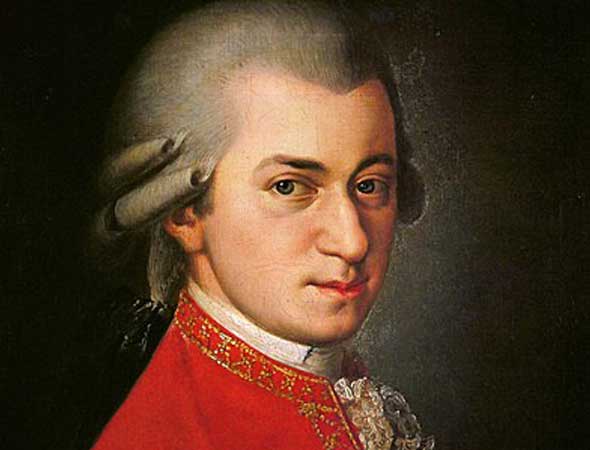MOZART: Symphony No. 41 “Jupiter”
Mozart’s 39th, 40th and 41st symphonies pose something of a musical mystery – especially No. 41, known as the “Jupiter” because it is the longest and most complex of his symphonies. Always hungry for commissions, Mozart almost never wrote a bar that was not dedicated to a commissioned work – least of all a major work such as a symphony. But the historical record offers us no evidence of a commission for these three works, which figure among his supreme masterpieces. Had he turned to writing these symphonies to express musical ideas too advanced or too personal for his commissions?
We’ll probably never know. But the idea of such using the symphonic form as a rubric for personal communication and experimentation is extremely appealing, and seems to prefigure Beethoven. Composers, especially symphonists, are fascinated by the accelerating creativity and daring that seemed to possess Mozart in the years before his death in 1791 (he completed the Jupiter in 1788). This symphony has been described as the work of a man who seemed ready to fly off the surface of the earth and enter a creative orbit all his own, beyond the reach of mere mortals. There is speculation that Mozart expected to sell his last three symphonies for presentation on an eventual tour of London, but again, history provides no solid evidence. It is not even certain whether Mozart ever heard his final three symphonies performed, though his musical mind had no need of a live performance to know how they would actually sound.

Wolfgang Amadeus Mozart
Unlike Beethoven’s most monumental symphonies, the Jupiter is known for its prevailing good cheer. Thanks to Gustav Holst, classical music fans know Jupiter as the bearer of jollity, but this nickname for Mozart’s 40th precedes Holst by a couple of centuries, dating back to Johann Peter Saloman, a German impresario who lived in London and produced a concert including the symphony in 1821. Saloman is credited with the first use of the name Jupiter for this work in a concert program.
Among the many composers who found inspiration in the Jupiter, Haydn modeled two of his own symphonies on it, Nos. 95 and 98 – tributes to a man who had been his pupil and whom he esteemed as the greatest composer he had ever known. But the most eloquent tribute probably came from a dean of Romantic music, Robert Schumann, who was a distinguished critic as well as a composer. “About many things in this world there is simply nothing to be said,” he wrote – “for example, about Mozart’s C-Major symphony with the fugue, much of Shakespeare, and some of Beethoven.”
Many listeners hear intimations of Romanticism in this symphony. But these are more related to its scope than its tone. While the Jupiter looks forward to Beethoven by expanding the horizons of the symphonic form, Mozart did not use the symphony to struggle through inner conflict of Enlightenment philosophy, as Beethoven did; instead, he introduced new formal structures and harmonic transitions that seemed to make Romanticism necessary by pushing Classical conventions beyond their known limits. By now, of course, innovations that once seemed daring and experimental sound beautifully natural to our ears.
The symphony’s opening movement has a sound that is emphatic and deep, yet there is also a sense of gladness that pervades it. Critics have noted the sense of authority that pervades the symphony from the outset and never gives way, yet its thematic materials and their development never push us toward pessimism. Its second movement is gentler and more subdued, and while it makes excursions into minor keys, the prevailing tone remains positive. The third movement, a traditional milnuet, prepares us for the final movement’s bold energy. One of the symphony’s most analyzed features is its signature coda (referenced above by Robert Schumann), strident and shocking yet somehow perfectly appropriate and beautiful.
When Mozart wrote this symphonic valediction, Beethoven was in his late teens and was already sketching themes upon which his great concertos would be based. Huge changes for the symphony were in the offing. Mozart, for his part, was only 31. What separates the musical landscape of his Jupiter Symphony from those created by Beethoven and his successors? Mozart’s mastery of the Jupiter’s expanded scope and its modern details make us certain that he could have taken the symphonic form as far as we can imagine, and beyond. What we do not hear in the Jupiter is the sense of conflict, struggle and resolution that we hear in Beethoven – or the esthetics of the Romantic symphony with man confronting nature, or in pursuit of an ideal, or presenting a programmed narrative. In the Jupiter Symphony, abstract beauty says it all.












